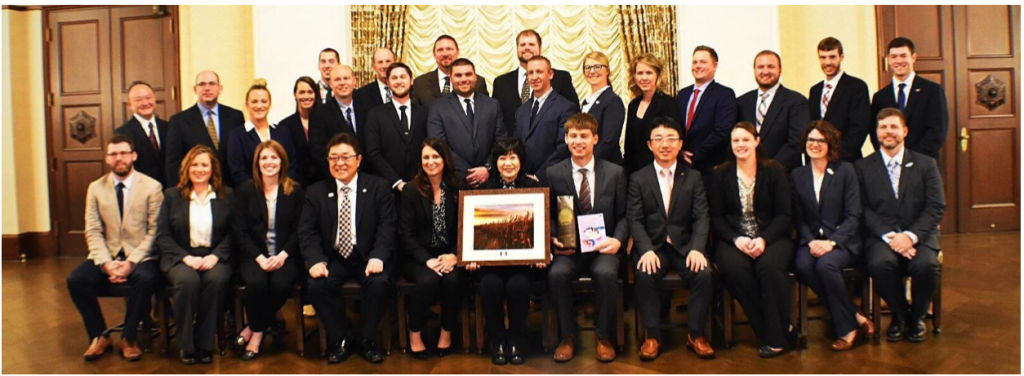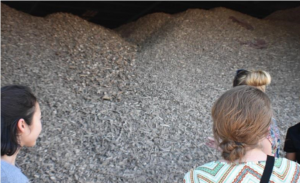Latham Seed Seller Takes International Mission through I-LEAD
Even before China retaliated earlier this month with a tariff on U.S. corn, soybeans, pork, beef and poultry, Iowans were working to develop other export markets for agricultural products. A group of 24 Iowans traveled March 5-16, 2018, to Japan and Vietnam as part of the Iowa Leadership Enhancement and Development (I-LEAD) program.
This mission trip marked the culmination of a two-year program for I-LEAD Class 8, a group of people selected to become strong leaders for Iowa agriculture and the ag industry. Mike Poeppe of Graettinger had the opportunity to visit Japan and Vietnam with I-LEAD. He serves as president of the Palo Alto County Corn Growers and also sells Latham® seed for Ritchie Berkland Seed Sales near Cylinder.
Poeppe took 15 pages of notes and more than 2,000 photographs throughout his 11-day mission trip. He says the biggest take away he had from the trip is the need to continually develop relationships that lead to new export markets for Iowa products. It’s clearly a win-win when U.S. ag products ship to foreign markets. We produce more than our country needs, and those countries need safe and reliable sources of food.
For example, Vietnam has twice the land mass of Iowa but more than 30 times the population! There simply are not open spaces there to grow crops, so imports are crucial. Vietnam imports 70% of its feed ingredients and is an important market for dried distillers grain (DDGs) produced as a co-product of U.S. ethanol production.
Consumers in Vietnam spend 60% of their income on food. Comparatively, Americans spend about 6% of their household income on food. Another contrast between consumers in these two countries is the way they shop. Due to limited available space in the country and smaller household incomes, housing units are much smaller in Vietnam.
Most Vietnamese families don’t own refrigerators, so consumers buy fresh meat and produce daily. The “wet market” for vegetables, flowers, nuts, seafood, and meat (primarily pork and chicken) takes place nightly with the exception of a few holidays.
“The wet market is like organized chaos. There are people and motor bikes everywhere,” says Poeppe. “This is where supply meets demand. Producers bring their goods here, so restaurants and consumers can purchase it fresh. Food safety procedures are very relaxed from what we see in the States.”
Another stop on the tour was an ethanol plant outside of Ho Chi Min. The plant runs on cassava but can switch to corn if the prices are right. Vietnam passed an E5 ethanol mandate in 2007, but the ethanol is in a trial period through 2018. Motor bikes in Vietnam produce more emissions than a typical car, so hopefully blending more ethanol will help reduce the air pollution.
The I-LEAD class also had dinner with grain buyers from Vietnam. The group discussed the opportunities and challenges that grain buyers face when importing corn.
“This was a good opportunity for as it allowed them to put a face on U.S. grain,” says Poeppe. “During this dinner, we helped answer questions that grain buyers had about U.S. product.”
Poeppe also found fish production interesting. His class visited a fish processor that specializes in frozen fish for export. That plant is fully vertically integrated as it raises and processes all the fish it sells. That operation feeds 12 ton of fish feed per month. It takes about a 10-month time period for fish to grow to market size. The fish are then sold wholesale. This operation recently added a greenhouse, so it can use “waste water” to grow vegetables in a hydroponics system. Now a second greenhouse is under construction.
Just as U.S. exports to Vietnam are strong due to our reputation for food safety standards, the branding of U.S. meat products has shown to be especially important to the Japanese.
“Japan is a very loyal customer for U.S. agricultural products,” says Poeppe. “Our visit with the Vice Governor of Yamanashi really opened our eyes to just how important this relationship is. We saw firsthand how the brand imaging created as a collaborative effort between U.S. Pork and U.S. Meat Export Federation has gotten desired results. Now there is 94% brand awareness for U.S. pork in Japan.”
Enjoy pork at home with this recipe for Honey Glazed Grilled Pork Chops from food.com.
HONEY GLAZED GRILLED PORK CHOPS
Ingredients:
- 1 cup ketchup
- 1⁄3 cup honey
- 1⁄4 cup soy sauce
- 2 cloves garlic, minced
- 1 1⁄2 lbs boneless pork chops (6 4 oz. portions)
- salt and pepper
Directions:




